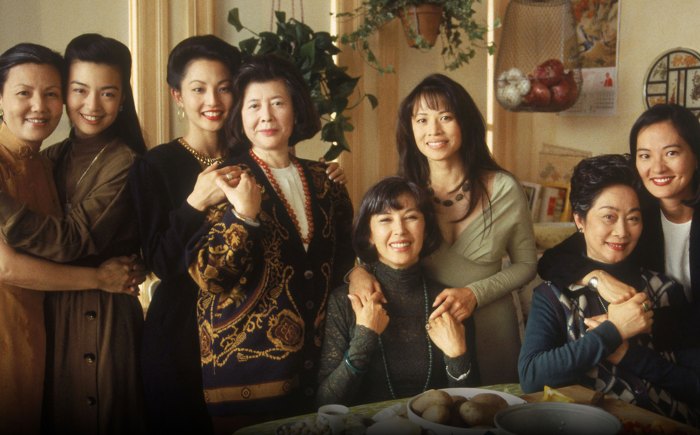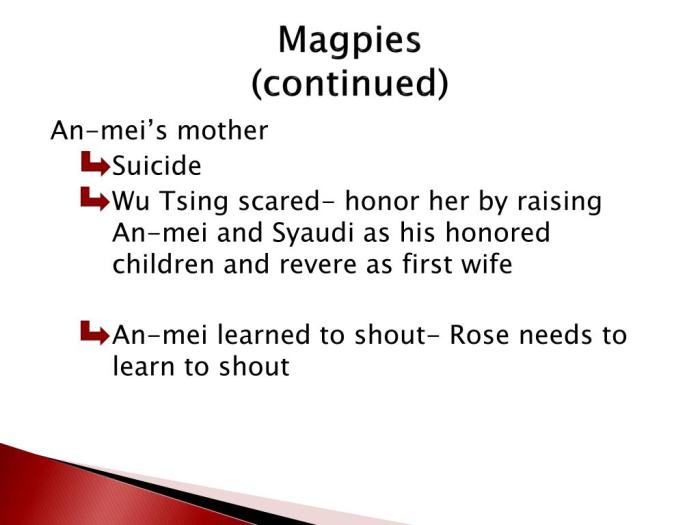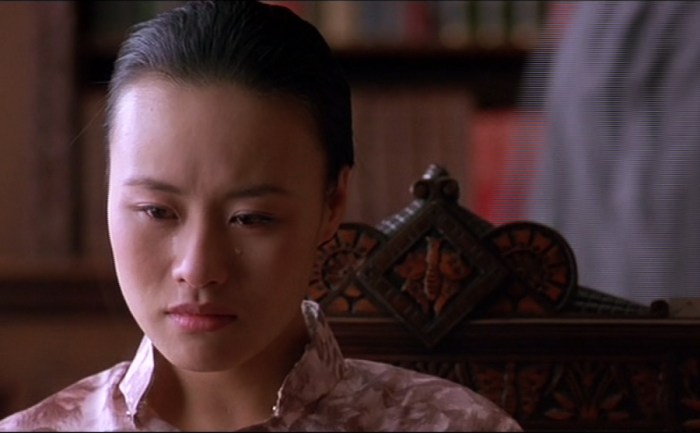Magpies the joy luck club – Magpies in “The Joy Luck Club” by Amy Tan are more than just birds; they are symbols of cultural heritage, family, and the complexities of identity. This captivating novel explores the lives of Chinese immigrant mothers and their American-born daughters through the lens of these enigmatic creatures.
From ancient Chinese folklore to Tan’s poignant storytelling, magpies play a pivotal role in shaping the narrative, adding depth and resonance to the characters’ journeys.
Magpies and Chinese Symbolism

In Chinese culture, magpies hold a significant place, imbued with profound symbolism and cultural significance. They are often associated with joy, happiness, and good fortune, and their presence is believed to bring blessings and prosperity.
The symbolism associated with magpies varies depending on the context and the number of magpies sighted. For instance, a single magpie may symbolize loneliness or separation, while a pair of magpies represents harmony and marital bliss.
Symbolism and Interpretation
The following table provides an overview of the various interpretations associated with magpies in Chinese culture:
| Symbolism | Interpretation | Example |
|---|---|---|
| Single Magpie | Loneliness, Separation | A solitary magpie perched on a branch may indicate a sense of isolation or a longing for companionship. |
| Pair of Magpies | Harmony, Marital Bliss | Two magpies flying together or building a nest symbolize a harmonious relationship or a happy marriage. |
| Three Magpies | Good Luck, Fortune | The sighting of three magpies is considered a sign of good luck and impending prosperity. |
| Four Magpies | Great Joy, Celebration | Four magpies represent immense happiness and the celebration of special occasions. |
| Five Magpies | Abundance, Wealth | Five magpies symbolize abundance, wealth, and material success. |
The Role of Magpies in “The Joy Luck Club”

In Amy Tan’s novel “The Joy Luck Club,” magpies hold significant symbolism and serve as a recurring motif throughout the story. Their presence weaves through the lives of the characters, contributing to their development and the unfolding of the narrative.
Magpies as Symbols of Joy and Fortune
Magpies are traditionally associated with joy, good fortune, and communication in Chinese culture. Within the novel, they often appear at moments of celebration or when characters experience unexpected joy. For example, when Lindo Jong wins a large sum of money in a lottery, a magpie is seen perched on her windowsill, symbolizing her newfound fortune.
Magpies as Messengers
Magpies are also known as messengers in Chinese folklore. In “The Joy Luck Club,” they serve as intermediaries between the characters and their past or future experiences. For instance, when June Woo is struggling to find her voice as a writer, a magpie appears in her dream, encouraging her to embrace her storytelling abilities.
Magpies as Connectors
Furthermore, magpies symbolize connection and unity. They often appear when characters are coming together or bridging cultural gaps. For example, when the Joy Luck Club members gather for their weekly meetings, a magpie is often seen outside their window, representing their bond and shared experiences.
The Magpies in Amy Tan’s “The Joy Luck Club” represent the power of storytelling and the preservation of cultural identity. Similarly, in the case of Kuha v. City of Minnetonka , the preservation of cultural practices is central to the case.
The Magpies, like the plaintiffs in Kuha, demonstrate the importance of preserving cultural traditions in the face of assimilation and modernization.
Cultural and Literary Comparisons

The symbolism of magpies varies across cultures, influencing their portrayal in literature. Let’s explore these differences and similarities.
Chinese Culture
- Good luck and fortune:Magpies are often associated with joy, happiness, and good news.
- Messengers of the gods:They are believed to carry messages between heaven and earth.
- Symbol of marriage:A pair of magpies represents marital harmony and fidelity.
Western Literature
- Omens of death and misfortune:Magpies are often seen as harbingers of bad luck or even death.
- Thieves and tricksters:They are sometimes depicted as cunning and mischievous creatures.
- Symbol of chattering and gossip:Their noisy calls are often associated with idle talk and rumors.
| Culture | Interpretation |
|---|---|
| Chinese | Good luck, joy, messengers, marriage |
| Western | Bad luck, misfortune, tricksters, gossip |
Magpies and Themes in “The Joy Luck Club”

Magpies, with their symbolic significance in Chinese culture, play a crucial role in exploring central themes within Amy Tan’s “The Joy Luck Club.” Their presence interweaves with the experiences of the mothers and daughters, reflecting and shaping the narratives that delve into family dynamics, identity formation, and the complexities of cultural heritage.
Family Bonds and Intergenerational Relationships
Magpies, known for their strong family ties, mirror the complex and evolving relationships within the families portrayed in the novel. Their territorial behavior and protective instincts parallel the fierce love and loyalty that bind the characters together. The presence of magpies often coincides with moments of familial tension or reconciliation, highlighting the intricate and unbreakable bonds that transcend generations.
For example, in the story “Scar,” Lindo Jong’s encounter with a magpie outside her daughter’s house signifies the enduring connection between mother and child despite their estrangement. The magpie’s persistent presence serves as a reminder of the unbreakable ties that unite them, foreshadowing their eventual reconciliation.
Cultural Identity and Assimilation
Magpies, with their contrasting black and white plumage, embody the duality of cultural identity faced by the Chinese-American characters in the novel. Their presence evokes a sense of displacement and the struggle to reconcile their Chinese heritage with their American upbringing.
In the story “The Joy Luck Club,” the daughters’ initial resistance to their mothers’ traditions is reflected in their discomfort with the magpies that frequent their gatherings. However, as they delve deeper into their heritage, they begin to embrace the magpies as symbols of their unique cultural identity.
Resilience and Transformation, Magpies the joy luck club
Magpies, known for their adaptability and resilience, resonate with the characters’ journeys of growth and transformation throughout the novel. Their ability to navigate different environments parallels the characters’ struggles to adapt to the challenges of their lives.
In the story “Half and Half,” Jing-Mei’s encounter with a magpie on the day of her piano recital symbolizes her transformation from a self-conscious girl to a confident young woman. The magpie’s presence provides her with a sense of inner strength and the courage to overcome her fears.
Essential Questionnaire: Magpies The Joy Luck Club
What is the significance of magpies in Chinese culture?
Magpies are often associated with joy, luck, and good fortune in Chinese culture.
How do magpies contribute to the character development in “The Joy Luck Club”?
Magpies serve as symbols of the characters’ cultural heritage and the challenges they face in navigating two worlds.
What is the difference in the symbolism of magpies in Chinese culture compared to Western literature?
In Chinese culture, magpies are generally seen as positive symbols, while in Western literature, they may be associated with thievery or mischief.